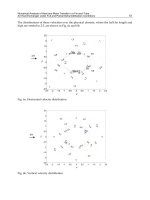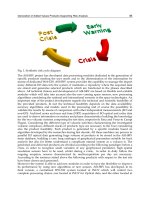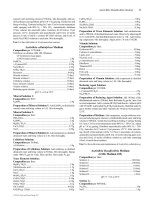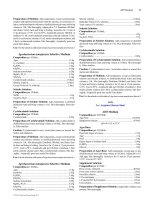Handbook of Plastics, Elastomers and Composites Part 4 docx
Bạn đang xem bản rút gọn của tài liệu. Xem và tải ngay bản đầy đủ của tài liệu tại đây (943.87 KB, 40 trang )
120 Chapter Two
2.5 Liquid Resin Processes
10
2.5.1 Potting Process
The processing of liquid potting compounds commences with dispersing curing agents
and other ingredients with a simple propeller mixer, producing potting compounds capable
of a variety of properties achieved by changes in formulations to gain stiffness, color,
strength, and electrical properties meeting specific needs and applications. The liquid pot-
ting compound is poured into a receptacle or jacket where the compound cures in place,
either with added heat or at ambient temperature. The receptacle or jacket remains as the
permanent outer skin of the final product. Proper compounding can produce articles with
negligible shrinkage and optical clarity along with a minimum of internal stress. Part and
mold design, coupled with the proper placement of the reinforcement, are calculated with
sophisticated computer software.
2.5.2 Potting Resin Selection
Tables 2.2 through 2.5 provide helpful information for guidance in the selection process
for potting resins.
2.5.3 Casting Process
The process for casting fluid monomeric resin compounds involves pouring the premixed
compound into a stationary mold (metal or glass) and then allowing the compound to cure
at ambient or elevated temperatures. The mold may contain objects that will have been
prepositioned in the mold and they become embedded by the resin as it cures. This tech-
nique can be done with minimal equipment and delicate inserts can he embedded, or they
can he introduced into the compound prior to the curing stage. The chief disadvantages are
that high-viscosity resins are difficult to handle and the occurrence of voids or bubbles can
present problems.
2.5.3.1 Cast epoxies. Cast epoxy resins have proven to be very popular in a wide va-
riety of applications because of their versatility, excellent adhesion, low cure shrinkage,
good electrical properties, compatibility with many other materials, resistance to weather-
ing and chemicals, dependability, and ability to cure under adverse conditions. Some of
their application fields are adhesives, coatings, castings, pottings, building construction,
chemical resistant equipment, and marine applications. The most widely used epoxy res-
ins in the casting field are the epi-bis and cycloaliphatic epoxies. Table 2.6 lists the proper-
ties of typical cured epi-bis resins with a variety of curing agents, and Table 2.7 provides
information on the properties of blends of cycloaliphatic epoxy resins.
Novolac epoxy resins, phenolic or cresol novolacs, are reacted with epichiorohydrin to
produce these novolac epoxy resins which cure more rapidly than the epi-bis epoxies and
have higher exotherms. These cured novolacs have higher heat-deflection temperatures
than the epi-bis resins as shown in Table 2.8. The novolacs also have excellent resistance
to solvents and chemicals when compared with that of an epi-bis resin as seen in Table 2.9.
2.5.3.2 Cast polyesters. General purpose polyester, when blended with a monomer
such as polystyrene and then cured, will produce rigid, rapidly curing transparent castings
exhibiting the properties shown in Table 2.10. Other monomers, in conjunction with poly-
styrene, such as alpha methyl styrene, methyl methacrylate, vinyl toluene, diallyl phtha-
Thermosets, Reinforced Plastics, and Composites
Downloaded from Digital Engineering Library @ McGraw-Hill (www.digitalengineeringlibrary.com)
Copyright © 2004 The McGraw-Hill Companies. All rights reserved.
Any use is subject to the Terms of Use as given at the website.
121
Thermosets, Reinforced Plastics, and Composites
Downloaded from Digital Engineering Library @ McGraw-Hill (www.digitalengineeringlibrary.com)
Copyright © 2004 The McGraw-Hill Companies. All rights reserved.
Any use is subject to the Terms of Use as given at the website.
122
Thermosets, Reinforced Plastics, and Composites
Downloaded from Digital Engineering Library @ McGraw-Hill (www.digitalengineeringlibrary.com)
Copyright © 2004 The McGraw-Hill Companies. All rights reserved.
Any use is subject to the Terms of Use as given at the website.
123
Thermosets, Reinforced Plastics, and Composites
Downloaded from Digital Engineering Library @ McGraw-Hill (www.digitalengineeringlibrary.com)
Copyright © 2004 The McGraw-Hill Companies. All rights reserved.
Any use is subject to the Terms of Use as given at the website.
124 Chapter Two
Thermosets, Reinforced Plastics, and Composites
Downloaded from Digital Engineering Library @ McGraw-Hill (www.digitalengineeringlibrary.com)
Copyright © 2004 The McGraw-Hill Companies. All rights reserved.
Any use is subject to the Terms of Use as given at the website.
125
Thermosets, Reinforced Plastics, and Composites
Downloaded from Digital Engineering Library @ McGraw-Hill (www.digitalengineeringlibrary.com)
Copyright © 2004 The McGraw-Hill Companies. All rights reserved.
Any use is subject to the Terms of Use as given at the website.
126
Thermosets, Reinforced Plastics, and Composites
Downloaded from Digital Engineering Library @ McGraw-Hill (www.digitalengineeringlibrary.com)
Copyright © 2004 The McGraw-Hill Companies. All rights reserved.
Any use is subject to the Terms of Use as given at the website.
127
Thermosets, Reinforced Plastics, and Composites
Downloaded from Digital Engineering Library @ McGraw-Hill (www.digitalengineeringlibrary.com)
Copyright © 2004 The McGraw-Hill Companies. All rights reserved.
Any use is subject to the Terms of Use as given at the website.
128 Chapter Two
late, triallyl cyanurate, divinyl benzene, and chlorostyrene, can be blended to achieve
specific property enhancements. The reactivity of the polyester used, as well as the config-
uration of the product, affect the choice of systems.
Flexible polyester resins are available that are tougher and slower curing and produce
lower exotherms and less cure shrinkage. They absorb more water and are more easily
scratched but show more abrasion resistance than the rigid type. Their property profile is
shown in Table 2.11. The two types, rigid and flexible, can be blended to produce interme-
diate properties, as shown in Table 2.12.
2.5.3.3 Cast polyurethanes. Polyurethanes are reaction products of an isocyanate, a
polyol, and a curing agent. Because of the hazards involved in handling free isocyanate,
prepolymers of the isocyanate and the polyol are generally used.
Thermosets, Reinforced Plastics, and Composites
Downloaded from Digital Engineering Library @ McGraw-Hill (www.digitalengineeringlibrary.com)
Copyright © 2004 The McGraw-Hill Companies. All rights reserved.
Any use is subject to the Terms of Use as given at the website.
Thermosets, Reinforced Plastics, and Composites 129
The choice of curing agent influences the curing characteristics and final properties. Di-
amines are the best general-purpose curing agent, as shown by Table 2.13. The highest
physical properties are produced using MOCA 4,4-methyl-bis (2chloroaniline). The other
major class of curing agents, the polyols, are more convenient to use, but the final products
have lower physical properties. By providing good abrasion resistance and a low coeffi-
cient of friction, polyurethanes find application in roller coatings and press pads as well as
gaskets, casting molds, timing belts, wear strips, liners, and heels and soles.
2.5.3.4 Cast phenolics. Phenolic casting resins are available as syrupy liquids pro-
duced in huge kettles by the condensation of formaldehyde and phenol at high temperature
in the presence of a catalyst and the removal of excess moisture by vacuum distillation.
These resins, when blended with a chemically active hardener, can be cast and cured solid
Thermosets, Reinforced Plastics, and Composites
Downloaded from Digital Engineering Library @ McGraw-Hill (www.digitalengineeringlibrary.com)
Copyright © 2004 The McGraw-Hill Companies. All rights reserved.
Any use is subject to the Terms of Use as given at the website.
130 Chapter Two
Thermosets, Reinforced Plastics, and Composites
Downloaded from Digital Engineering Library @ McGraw-Hill (www.digitalengineeringlibrary.com)
Copyright © 2004 The McGraw-Hill Companies. All rights reserved.
Any use is subject to the Terms of Use as given at the website.
Thermosets, Reinforced Plastics, and Composites 131
in molds constructed from various materials and of a variety of mold designs. They will
exhibit a broad-based property profile as described in Table 2.14. The mold designs avail-
able are draw molds, split molds, cored molds, flexible molds, and plaster molds.
2.5.3.5 Cast allylics.
11
The allylic ester resins possess excellent clarity, hardness,
and color stability and thus can be cast to form optical parts. These castings can be either
homo or co-polymers. The free radical addition polymerization of the allylic ester presents
some casting difficulties such as exotherm control, monomer shrinkage during curing and
the interaction between the exotherm, the free radical source, and the environmental heat
required to decompose the peroxide and initiate the reaction.
A simple casting formulation is as follows:
Prepolymer: 60 parts/wt
Monomer: 40 parts/wt
Thermosets, Reinforced Plastics, and Composites
Downloaded from Digital Engineering Library @ McGraw-Hill (www.digitalengineeringlibrary.com)
Copyright © 2004 The McGraw-Hill Companies. All rights reserved.
Any use is subject to the Terms of Use as given at the website.
132 Chapter Two
Thermosets, Reinforced Plastics, and Composites
Downloaded from Digital Engineering Library @ McGraw-Hill (www.digitalengineeringlibrary.com)
Copyright © 2004 The McGraw-Hill Companies. All rights reserved.
Any use is subject to the Terms of Use as given at the website.
Thermosets, Reinforced Plastics, and Composites 133
Tert-butyl perbenzoate: 2 parts/wt
Tert-butylcatechol: 0.1 parts/wt
The function of the catechol is to retard the polymerization and the exothermic heat
over a longer time period, allowing the heat to dissipate and minimize cracking. Monomer
catalyzed with benzoyl peroxide or tert-butyl perbenzoate may be stored at room tempera-
ture from 2 weeks to 1 year, but, at 120°F (49°C), the catalyzed resin will gel in a few
hours.
Molds for casting allylics may be ground and polished metal or glass, with glass being
the preferred type, since it is scratch resistant and able to take a high polish.
Cast allylics are noted for their hardness, heat resistance, electrical properties, and
chemical resistance as shown in Tables 2.15 and 2.16. They do lack strength, so their us-
age is confined to optical parts and some small electrical insulators.
Allylic monomers are sometimes used with alkyds to produce polyesters, with the ortho-
phthalate resin being the most widely used because of its lower cost and very low water va-
por pressures. Alkyd-diallylphthalate copolymers have significantly lower exotherm than an
alkyd-styrene copolymer. The electrical properties of allylic resins are excellent, and the
variations of dissipation factor, dielectric constant, and dielectric strength with temperature
and frequency are given in Figs. 2.12 and 2.13. The surface and volume resistivities remain
high after prolonged exposure to high humidity. Resistance to solvents and acids is excel-
lent, along with good resistance to alkalies. Tables 2.17 and 2.18 compare the chemical re-
sistance of some plastics with the chemical resistance of the DAIP formulations.
2.6 Laminates
12
2.6.1 Laminates
Laminates can be defined as combinations of liquid thermosetting resins with reinforcing
materials that are bonded together by the application of heat and pressure, forming an in-
fusible matrix. Plywood is a good example of a thermosetting laminate with the phenolic
resin serving as the binder to bond the layers of wood sheets together when compressed
with heat in a molding press.
2.6.2 Resins
The resin systems primarily used for laminates are bismaleimides, epoxies, melamines,
polyesters, polyimides, silicones, and phenolics and cyanate esters. These resins are de-
scribed in Sec. 2.7.8, and the reinforcements are described in Sec. 2.6.3.
2.6.3 Reinforcements
Glass fibers are the most commonly used laminate reinforcement and are available in
some six formulations, with the E-glass providing excellent moisture resistance, which, in
turn, results in superior electrical properties along with other valuable properties. Proper-
ties of reinforced plastics using a variety of reinforcing fibers are shown in Table 2.19.
Compositions of the major types of glass fibers are shown in Table 2.20. The glass fibers
are available in filaments, chopped strands, mats, and fabrics in a wide variety of diame-
ters, as described in Table 2.21.
Glass fabrics: Many different fabrics are made for reinforced plastics, with E-glass be-
ing the most common. Filament laminates using glass types of D, G, H, and K are also
Thermosets, Reinforced Plastics, and Composites
Downloaded from Digital Engineering Library @ McGraw-Hill (www.digitalengineeringlibrary.com)
Copyright © 2004 The McGraw-Hill Companies. All rights reserved.
Any use is subject to the Terms of Use as given at the website.
134
Thermosets, Reinforced Plastics, and Composites
Downloaded from Digital Engineering Library @ McGraw-Hill (www.digitalengineeringlibrary.com)
Copyright © 2004 The McGraw-Hill Companies. All rights reserved.
Any use is subject to the Terms of Use as given at the website.
Thermosets, Reinforced Plastics, and Composites 135
common with the filaments combined into strands, and the strands plied into yarns. These
yarns can be woven into fabrics on looms.
2.6.4 Processes
The liquid resins are poured onto the reinforcement material and the combined resin-rein-
forcement sheet is then placed in a “horizontal treater,” as shown in Fig. 2.12, where the
resin is dissolved in a solvent to achieve optimum wetting or saturation of the resin into
the reinforcement. The sheets come out of the treater and are sheared to size and stacked
Thermosets, Reinforced Plastics, and Composites
Downloaded from Digital Engineering Library @ McGraw-Hill (www.digitalengineeringlibrary.com)
Copyright © 2004 The McGraw-Hill Companies. All rights reserved.
Any use is subject to the Terms of Use as given at the website.
136 Chapter Two
and stored in temperature- and humidity-controlled rooms. The preimpregnated, stacked
sheets are further stacked into packs with each pack containing 10 laminates. The stacked
units are then placed in between two polished steel plates, and the press is closed. This
process involves molding temperatures ranging from 250 to 400°F (122 to 204°C), with
molding pressures in the 200- to 3000-lb/in
2
range.
The press may have 24 platens, making a press load of some 240 laminates each cycle.
After molding, the laminates are trimmed to final size and sometimes postcured by heating
them in ovens.
2.6.5 Properties
2.6.5.1 Physical and mechanical. The use of reinforcements in combination with
thermosetting resins will produce laminates exhibiting higher tensile, compressive, and
Figure 2.12 (a) Horizontal treater and (b) decorative laminate treater. (Source: Charles A.
H
arper, Handbook of Plastics, Elastomers, and Composites, 3d ed., McGraw-Hill, New York,
1996, p. 2.2)
Thermosets, Reinforced Plastics, and Composites
Downloaded from Digital Engineering Library @ McGraw-Hill (www.digitalengineeringlibrary.com)
Copyright © 2004 The McGraw-Hill Companies. All rights reserved.
Any use is subject to the Terms of Use as given at the website.
Thermosets, Reinforced Plastics, and Composites 137
flexural strengths due to the polymerization of the resin with its property enhancement
contribution to the matrix. The impact strength sometimes improves by a factor of 10, and
the laminates have no clear yield point, as shown in Fig. 2.13 (stress and strain).
Reinforced thermosetting laminates are anisotropic, with their properties differing de-
pending upon the direction of measurement. The properties of a fabric laminate are con-
trolled by the weave of the fabric and the number and density of the threads in the warp
and woof directions, with these values differing from the values in the z of thickness direc-
tion. Both thermal expansion and conductivity properties are also anisotropic, as displayed
in Table 2.22.
2.6.5.2 Electrical. The dielectric strength of laminates will decrease with increasing
thickness and is highly dependent upon the direction of the electric field stress. This
property will show higher when tested across the sample’s thickness, whereas end-to-
end testing will show lower values. Laminates with higher resin content will show bet-
ter electrical properties but poorer physical properties than laminates with lower resin
content.
2.6.5.3 Dimensional stability. Laminates using thermosetting resins are superior in
stability, thermal resistance, and electrical properties, with dimensional stability the most
important due to stresses incurred within the laminate during the molding and curing pro-
Figure 2.13 Stress-strain curves for various materials. (a) Rein-
forced plastics, (b) wood and most metals, and (c) steel. (Source:
Charles A. Harper, Handbook of Plastics, Elastomers, and Compos-
ites, 3d ed., McGraw-Hill, New York, 1996, p. 2.3)
Thermosets, Reinforced Plastics, and Composites
Downloaded from Digital Engineering Library @ McGraw-Hill (www.digitalengineeringlibrary.com)
Copyright © 2004 The McGraw-Hill Companies. All rights reserved.
Any use is subject to the Terms of Use as given at the website.
138
Thermosets, Reinforced Plastics, and Composites
Downloaded from Digital Engineering Library @ McGraw-Hill (www.digitalengineeringlibrary.com)
Copyright © 2004 The McGraw-Hill Companies. All rights reserved.
Any use is subject to the Terms of Use as given at the website.
Thermosets, Reinforced Plastics, and Composites 139
cess. Laminate thickness is limited by the thermal conductivity of the polymerizing resin
and the thermal conductivity of the cured laminate. The laminate derives its heat from the
press platens to begin the curing action, and the resin, as it polymerizes, will produce sub-
stantial reactive heat, making it difficult to produce very thick laminates. The normal
thickness range for laminates will range from 0.002 to about 2.000 in with special grades
produced at 4 to 10 in.
2.7 Molding Compounds
2.7.1 Resin Systems
Thermosetting resin systems are the backbone of a large, versatile, and important family
of molding compounds. This family provides the industrial, military, and commercial mar-
kets with plastic molding materials exhibiting exceptional electrical, mechanical, thermal,
and chemical properties. These important property values enable the product designer,
manufacturing engineer, and research and design engineer to select from a wide choice of
products, and enable them to choose the most suitable molding compound to meet their
specific needs and requirements. These versatile materials are covered by military, indus-
trial, and commercial specifications that are designed to ensure the quality of the molded
articles utilizing thermosetting molding compounds.
Thermosets, Reinforced Plastics, and Composites
Downloaded from Digital Engineering Library @ McGraw-Hill (www.digitalengineeringlibrary.com)
Copyright © 2004 The McGraw-Hill Companies. All rights reserved.
Any use is subject to the Terms of Use as given at the website.
140
Thermosets, Reinforced Plastics, and Composites
Downloaded from Digital Engineering Library @ McGraw-Hill (www.digitalengineeringlibrary.com)
Copyright © 2004 The McGraw-Hill Companies. All rights reserved.
Any use is subject to the Terms of Use as given at the website.
Thermosets, Reinforced Plastics, and Composites 141
The following sections will take each of the family members, in alphabetical order, and
outline their history; specifications; and reinforcements, fillers, and data sheet value appli-
cations.
2.7.2 AIlyls: Diallyl-ortho-phthalate (DAP) and Diallyl-iso-phthalate (DAIP)
2.7.2.1 History.
13
The most sophisticated work on saturated polyesters is usually
traced to W. H. Carothers, who, from 1928 to 1935 with DuPont, studied polyhydroxy
condensates of carbolic acids. Unable to achieve suitable heat and chemical resistance
from these esters, he turned to polyamide-carboxylic acid reaction products, which later
became nylon. Carothers’ concepts on saturated polyesters yielded several other polyester
products such as Terylene, which became patented and introduced in the United States as
dacron and mylar.
In 1937, Carlton Ellis found that unsaturated polyesters, which are condensation prod-
ucts of unsaturated dicarboxylic acids and dihydroxy alcohols, would freely co-polymerize
with monomers that contained double bond unsaturation, yielding rigid thermosetting res-
ins. The allylic resins became commercial resins suitable for compounding into a broad
range of products with exceptional electrical, mechanical, thermal, and chemical properties.
2.7.2.2 Physical forms. Molding compounds using either the DAP or the DAIP resin
systems are available in free-flowing granular form and also in high-bulk factor flake form.
The resins are in a white powder form, which makes it possible to provide a broad opaque
color range. Both compounds in their granular form are readily molded, preformed, or pre-
plasticated automatically, whereas the high-bulk-factor compounds generally require aux-
iliary equipment for such operations.
2.7.2.3 Reinforcements. Compounds of either DAP or DAIP resin systems utilize a
variety of reinforcement materials ranging from the granular compounds with mineral,
Thermosets, Reinforced Plastics, and Composites
Downloaded from Digital Engineering Library @ McGraw-Hill (www.digitalengineeringlibrary.com)
Copyright © 2004 The McGraw-Hill Companies. All rights reserved.
Any use is subject to the Terms of Use as given at the website.
142
Thermosets, Reinforced Plastics, and Composites
Downloaded from Digital Engineering Library @ McGraw-Hill (www.digitalengineeringlibrary.com)
Copyright © 2004 The McGraw-Hill Companies. All rights reserved.
Any use is subject to the Terms of Use as given at the website.
143
Thermosets, Reinforced Plastics, and Composites
Downloaded from Digital Engineering Library @ McGraw-Hill (www.digitalengineeringlibrary.com)
Copyright © 2004 The McGraw-Hill Companies. All rights reserved.
Any use is subject to the Terms of Use as given at the website.
144 Chapter Two
glass, and synthetic fibers to the high-strength, high-bulk factor types employing long fi-
bers of cotton flock, glass, acrylic, and polyethylene terephthalate.
2.7.2.4 Specifications. DAP and DAIP molding compounds meet the requirements
of several commercial and military specifications as well as those of certain industrial and
electronic firms who will often use the Mil spec in conjunction with their own special re-
quirements.
Military
Mil-M-14 DAP (ortho) compounds:
MDG: Mineral filler, general purpose
SDG: Short glass filler, general purpose
SDG-F: Short glass filler, flame resistant
SDI-5: OrIon filler, impact value of 0.5 ft-lb
SDI-:30: Dacron filler, impact value of 3.0 ft-lb
GDI-30: Long glass filler, impact value of 3.0 ft-lb
GDI-30F: Long glass filler, impact value of 3.0 ft-lb, flame resistant
GDI-300: Long glass filler, impact value of 30 ft-lb
GDI-300F: Long glass filler, impact value of 30 ft-lb, flame resistant
DAIP (iso) compounds. Mil-M-14 H lists designations for the (iso) compounds and re-
fers to them as heat-resistant compounds:
MIG: Mineral filler, heat resistant
MIG-F: Mineral filler, heat and flame resistant
SIG: Short glass filler, heat resistant
SIG-F: Short glass filler, heat and flame resistant
GII-30: Long glass filler, heat resistant, impact value of 3.0 ft-lb
GII-30-F: Long glass filler, heat and flame resistant, impact value of 30 ft-lb
Note: All of these DAIP compounds will perform without substantial property loss dur-
ing exposure to elevated temperatures of 490°F (200°C).
ASTM. Under D-1636-75 A, both DAP and DAIP are listed by type, class and grade as
shown below:
Thermosets, Reinforced Plastics, and Composites
Downloaded from Digital Engineering Library @ McGraw-Hill (www.digitalengineeringlibrary.com)
Copyright © 2004 The McGraw-Hill Companies. All rights reserved.
Any use is subject to the Terms of Use as given at the website.









